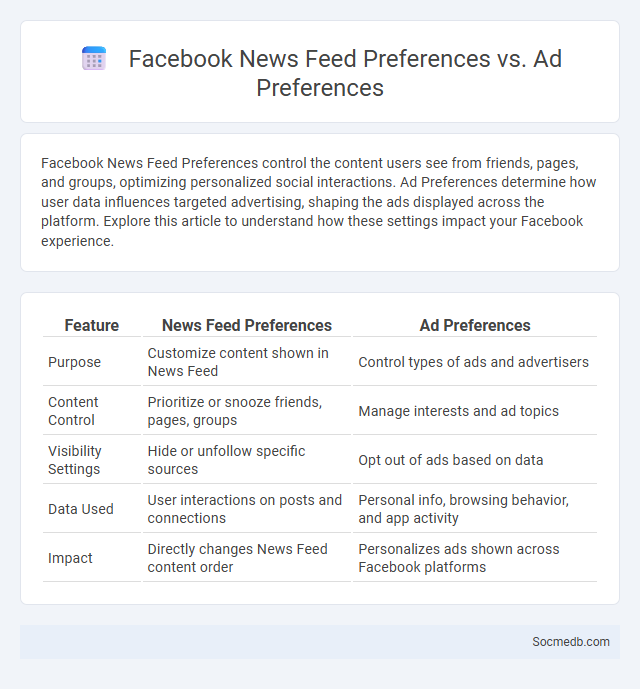
Photo illustration: Facebook News Feed Preferences vs Ad Preferences
Facebook News Feed Preferences control the content users see from friends, pages, and groups, optimizing personalized social interactions. Ad Preferences determine how user data influences targeted advertising, shaping the ads displayed across the platform. Explore this article to understand how these settings impact your Facebook experience.
Table of Comparison
| Feature | News Feed Preferences | Ad Preferences |
|---|---|---|
| Purpose | Customize content shown in News Feed | Control types of ads and advertisers |
| Content Control | Prioritize or snooze friends, pages, groups | Manage interests and ad topics |
| Visibility Settings | Hide or unfollow specific sources | Opt out of ads based on data |
| Data Used | User interactions on posts and connections | Personal info, browsing behavior, and app activity |
| Impact | Directly changes News Feed content order | Personalizes ads shown across Facebook platforms |
Overview: Facebook News Feed Preferences vs Ad Preferences
Facebook News Feed Preferences allow You to customize the content displayed on Your feed by prioritizing posts from friends, pages, and groups, enhancing Your browsing experience. Ad Preferences control the types of advertisements shown based on Your interactions, interests, and demographic data, ensuring relevance in promotional content. Both settings offer distinct customization options to optimize how information and ads are presented, improving engagement and personal relevance on the platform.
Understanding Facebook News Feed Preferences
Facebook News Feed Preferences allow you to customize content visibility by prioritizing posts from selected friends, pages, and groups, enhancing your social media experience. Utilizing these settings, you can control which updates appear first, filter out unwanted content, and manage notification preferences to stay informed about relevant activities. Understanding and regularly updating your News Feed Preferences ensures your feed reflects your interests, improving engagement and satisfaction on the Facebook platform.
Customizing Your News Feed: What You Can Control
Customizing your social media news feed involves managing algorithms that prioritize content based on your interactions, interests, and preferences. Platforms like Facebook, Instagram, and Twitter allow users to control what appears by adjusting settings such as unfollowing, muting, or prioritizing accounts and topics. Leveraging these controls ensures a personalized and relevant feed, enhancing user engagement and reducing unwanted content.
Navigating Facebook Ad Preferences
Understanding Facebook Ad Preferences empowers users to control the types of advertisements displayed in their feeds, enhancing personalization while safeguarding privacy. By adjusting settings related to interests, advertisers, and ad information, individuals can optimize ad relevance and reduce unwanted content exposure. Managing these preferences improves user experience by aligning ads with personal values and online behavior patterns.
Differences Between News Feed and Ad Preferences
News Feed on social media platforms displays a personalized stream of posts, updates, and content from friends, pages, and groups based on user interactions and engagement patterns. Ad Preferences, however, control the types of advertisements users see by managing interests, behaviors, and demographic data that platforms utilize for targeted marketing. Understanding these distinctions helps users customize content visibility while maintaining control over advertisement relevance and personalization.
How Facebook Curates Content in Your Feed
Facebook curates content in your feed using an advanced algorithm that prioritizes posts based on your past interactions, preferences, and behaviors. The platform analyzes factors such as likes, comments, shares, and dwell time to personalize your experience by showing you content it predicts you'll find most relevant and engaging. Your feed continuously adapts, ensuring the most meaningful posts from friends, pages, and groups appear prominently to enhance your social media engagement.
Impact of Preferences on User Experience
User preferences significantly shape social media algorithms, enhancing personalized content delivery that boosts engagement and satisfaction. Customizable features such as theme settings, content filters, and notification controls align the platform experience closely with individual tastes and behaviors. This tailored interaction fosters deeper user retention and promotes positive sentiments towards the social media ecosystem.
Privacy and Data: What Facebook Tracks
Facebook tracks extensive data including your location, browsing history, interests, and interactions to personalize ads and improve user experience. This information is collected through your activity on the platform, third-party websites with Facebook plugins, and connected apps. Understanding these practices helps you manage your privacy settings and control the data shared on social media.
Optimizing Preferences for Better Engagement
Optimizing social media preferences involves tailoring content types, posting times, and audience targeting based on platform analytics to maximize engagement rates. Utilizing tools like Facebook Insights, Instagram Analytics, and Twitter Analytics enables precise adjustments in strategy, leading to higher click-through, share, and interaction metrics. Consistent analysis and adaptation foster stronger community connections and enhance overall digital brand presence.
Future Trends in Facebook Personalization
Facebook personalization is advancing through AI-driven algorithms that analyze user behavior to deliver hyper-targeted content and ads, increasing engagement rates significantly. Enhanced biometric and voice recognition features enable more secure and intuitive user experiences, fostering deeper connections within the platform. Predictive analytics and machine learning models forecast user preferences in real time, allowing Facebook to tailor feeds dynamically and boost user retention.
 socmedb.com
socmedb.com